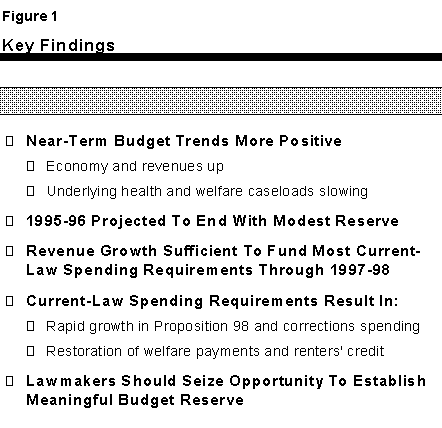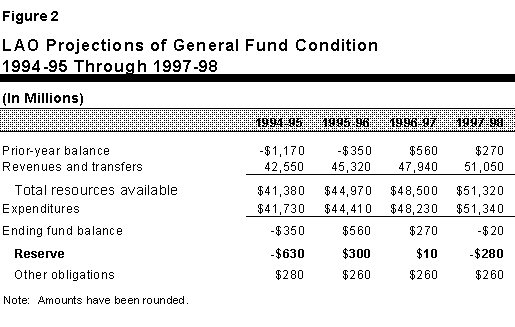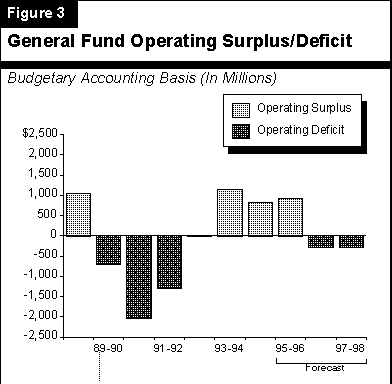FOREWORD
This report provides our projections of the General Fund condition for 1995-96 through 1997-98. It includes our independent assessment of the outlook for the economy, demographics, revenues, and expenditures. It is designed to assist the Legislature with its long-term fiscal planning.
Chapter 1 contains our principal findings and conclusions. Chapter 2 presents our economic and demographic projections, Chapter 3 our revenue forecasts, and Chapter 4 our expenditure projections. Chapter 5 discusses alternative budget outcomes which could result under a variety of circumstances other than those assumed in our projections. These include a weaker economy, the adoption of federal health and welfare reforms, adverse litigation, differing caseload and enrollment trends, and other factors.
Our fiscal projections reflect current-law spending requirements and tax provisions. They are not predictions of future policy decisions by the Legislature, nor are they our recommendations as to what spending and revenue levels should be. The report is the first of an ongoing series and will be updated periodically.
CHAPTER 1
The Budget Outlook
This report presents our economic and budget outlook for fiscal years 1995-96 through 1997-98. Figure 1 summarizes our key findings.

OVERVIEW
In each of the past five fiscal years, the Legislature and Governor have faced multi- billion dollar budget gaps. The near-term fiscal outlook is now significantly more favorable. As shown in Figure 2 (see page 2), we estimate that the state will end 1995-96 with a modest reserve. And while revenue growth in 1996-97 and 1997-98 will not be sufficient to fund all of the expenditures required by current law, there will be adequate funds to meet most of these requirements. The more positive budget outlook is related to three general factors:
- First, the economic and revenue outlook has improved markedly. We project that General
Fund revenues will grow at an average annual rate of about 6.3 percent between 1994-95 and
1997-98, which is significantly higher than combined inflation and population increases. The
revenue increases are a sharp contrast to the declines that occurred in the early 1990s.
- Second, underlying caseload growth has slowed dramatically in the state's health and
welfare programs, reflecting past policy changes, improving economic conditions, and
changes in demographic trends.
- Third, revenues in 1995-96 are exceeding expenditures by over $900 million as a result of past legislative actions (spending cuts, funding shifts to other levels of government, and revenue increases). This operating surplus will pay off the accumulated deficit, and enable the state to begin a new fiscal year with a modest reserve for the first time since the recession began.

KEY FEATURES OF OUTLOOK
Basis for Our Estimates -- Current Law
Our budget forecast is based on the requirements in current law regarding revenues and expenditures. Specifically, we have adjusted the 1995-96 spending plan for constitutional and statutory requirements, as well as projected changes in prices, caseloads, and workloads. More specifically, we increased K-14 education funding in accordance with Proposition 98 spending requirements, and have provided for the restoration of welfare grant levels and the renters' credit in 1996-97, as required by existing statutes.We would stress that our fiscal estimates are neither predictions of what the Legislature and Governor will eventually enact in coming budgets, nor are they our recommendations as to what spending and revenue levels should be. Rather, our estimates are based on what would happen if current policies were allowed to run their course. We believe they provide a meaningful starting point for the Legislature's evaluation of the state's fiscal condition, and its assessment of any necessary changes to the state's taxing and spending levels.
Economic and Revenue Outlooks -- Moderate Growth
A key reason for the improving budget outlook is the economy. Recent developments clearly indicate that California's economy is on the upswing, and our economic forecast assumes that the state will continue to experience moderate growth and low inflation during the next three years. We project that California personal income and payroll employment will grow at average annual rates of 5.8 percent and 2.2 percent, respectively, between 1995 and 1998. Consistent with this moderate-growth economic outlook, we project that revenues will increase at an average annual rate of about 6.3 percent between 1994-95 and 1997-98.
1995-96 to End With Modest Reserve
The improving economy is having a positive impact on the current-year budget outlook. We project that 1995-96 will end with a reserve of $300 million, compared with the 1995-96 budget estimate of $28 million. The improvement is primarily related to stronger revenues, which we estimate will exceed the budget forecast by $1.3 billion this fiscal year. Under Proposition 98, about one half of the revenue gain would go towards increased K-14 school funding. Thus, the net increase to the General Fund's reserve would be about $700 million.Partly offsetting this net revenue increase are additional state expenditures related to (1) partial loss of budgeted federal reimbursements, (2) a delay in federal law changes needed to implement certain welfare reductions assumed in the 1995-96 spending plan, and (3) higher state spending requirements for schools due to slightly higher enrollments and slightly lower-than-anticipated local property tax growth.
Budgets Nearly in Balance Through 1997-98
We estimate that revenues will fall short of current-law spending requirements in 1996-97 and 1997-98 (see Figure 3). As a result, the reserve will fall from $300 million in the current year, to $10 million next year, and to a deficit of $280 million in 1997-98, absent corrective action. 
It should be stressed that the budget imbalances are not due to weak revenue growth. As indicated above, we project that revenues will increase at an annual rate of more than 6 percent during the next two years. Rather, the shortfalls are due to major expenditure increases that are required by existing law. As a result, total spending would increase by 7.5 percent annually over the next two years. This relatively rapid overall growth rate primarily reflects large spending increases in three key areas:
- Proposition 98 K-14 Education Spending. Projected General Fund costs
to meet Proposition 98 spending requirements (the largest single spending component in the
budget) increase by an average of 9.4 percent annually over the next two years. However,
combined state and local funding available to schools and community colleges will grow
somewhat more slowly than state funding (about 7.5 percent annually). This is because state
funds must offset projected slower growth in local property tax revenue.
- Prisons. Continued growth in prison inmate populations increases
support costs for the Department of Corrections by a projected 9.9 percent annually over the
next two years.
- Restorations of Welfare Grants and Renters' Credit. Existing law requires that welfare grants for the Aid to Families with Dependent Children (AFDC) and the Supplemental Security Income/State Supplementary Program (SSI/SSP) be increased in 1996-97. This is because a 5.8 percent grant reduction enacted in 1992-93 and a 4.9 percent grant reduction enacted in the current year sunset at the end of 1995-96. In addition, the current suspension of the renters' tax credit program ends in 1995, which increases spending by about $500 million annually. In combination, these restorations add about $1.6 billion to the spending totals in both 1996-97 and 1997-98.
IMPLICATIONS OF OUR OUTLOOK
Our forecast for near-term budget improvement does not imply that California's fiscal health is fully restored. The state continues to face expenditure pressures relating to the continuing fiscal stress of counties, expanding prison populations, and demands for infrastructure spending, as well as an ongoing need to assess the viability of its tax structure and business climate. In addition, there are a number of risks to our forecast--including an economic slowdown and possible adverse court decisions--which could cause a serious deterioration in the budget outlook even in the next two years. Finally, the state will have to address whatever welfare and Medi-Cal changes that are enacted by the federal government.
For these reasons, the Legislature will face many tough decisions in the coming year and beyond. The more favorable outlook does, however, provide lawmakers with the opportunity to establish long-term budget priorities and address some of the above- mentioned issues in a more stable fiscal environment. At a minimum, we believe that the Legislature should seize the opportunity to establish a meaningful budget reserve.
